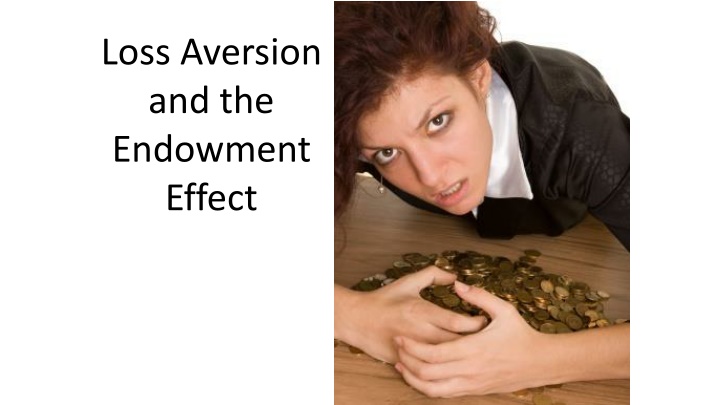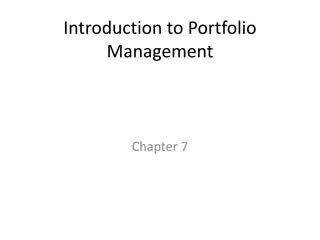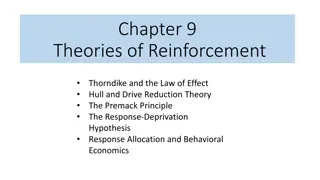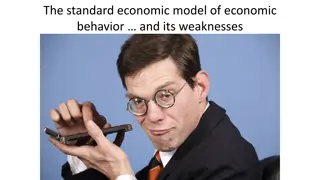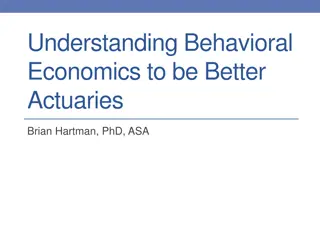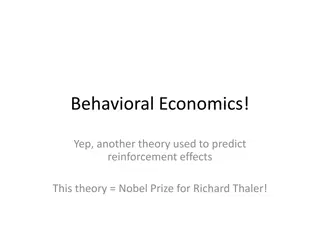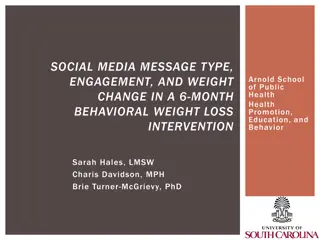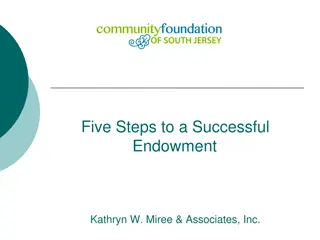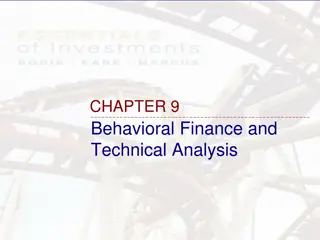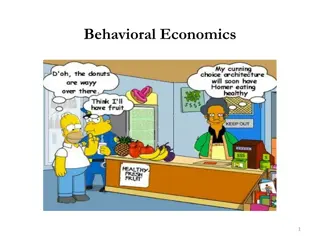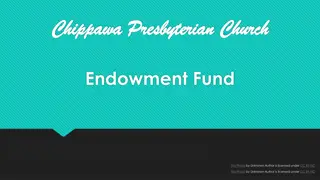Loss Aversion and the Endowment Effect: Understanding Behavioral Economics
This content explores the concept of Loss Aversion and the Endowment Effect in behavioral economics through key theories like Prospect Theory, Gains and Losses relative to a reference point, and the impact on decision-making. With insights from Daniel Kahneman and Richard Thaler's works, it delves into how individuals are more motivated to avoid losses than to acquire gains and how our reactions to gains and losses are influenced by reference points. Discover the nuanced ways in which people react to different outcomes and the implications for decision-making processes.
Download Presentation

Please find below an Image/Link to download the presentation.
The content on the website is provided AS IS for your information and personal use only. It may not be sold, licensed, or shared on other websites without obtaining consent from the author.If you encounter any issues during the download, it is possible that the publisher has removed the file from their server.
You are allowed to download the files provided on this website for personal or commercial use, subject to the condition that they are used lawfully. All files are the property of their respective owners.
The content on the website is provided AS IS for your information and personal use only. It may not be sold, licensed, or shared on other websites without obtaining consent from the author.
E N D
Presentation Transcript
Loss Aversion and the Endowment Effect
Reading Thinking, Fast and Slow by Daniel Kahneman Chapter 26: Prospect Theory, Loss Aversion Misbehaving by Richard Thaler Chapter 4: Value Theory Nudge by Richard Thaler and Cass Sunstein Chapter 1: Biases and Blunders, Gains and Losses
Prospect Theory This is easily the most famous theoretical contribution to behavioral economics Prospect Theory: An Analysis of Decision under Risk, by Daniel Kahneman and Amos Tversky, Econometrica, Vol. 47, No. 2 (March 1979), pp. 263-292 One of the key components of prospect theory is loss aversion
People are more motivated to avoid a loss than to acquire a similar gain.
Gains and Losses Relative to a Reference Point In The Undoing Project by Michael Lewis, Daniel Kahneman is described as imagining the following scenario (p. 267): Yesterday, Jack had $1 million and Jill had $9 million. Today Jack and Jill each have $5 million. Assuming they are otherwise identical, are they equally happy? Standard economics would say they are equally happy Kahneman concluded that Jill was obviously less happy than Jack
Gains and Losses Relative to a Reference Point In The Undoing Project by Michael Lewis, Daniel Kahneman is described as imagining the following scenario (p. 267): Yesterday, Jack had $1 million and Jill had $9 million. Today Jack and Jill each have $5 million. Assuming they are otherwise identical, are they equally happy? What matters is whether an outcome is a gain or a loss relative to each person s reference point (or, in this case, the status quo)
Loss Aversion, Measured Daniel Kahneman on loss aversion: http://www.youtube.com/watch?v=VorB7X5L8ZY&feature=rel ated Experiment after experiment has shown that people will accept a gamble with equal odds of a loss and a gain, as long as the gain is roughly 2.5 times the loss
Gains, Losses and the Reference Outcome People react differently to gains and losses. It is important to people whether an outcome is a gain or a loss. This means that people classify each outcome as either a gain or a loss. This means that people compare each outcome to a reference outcome (or status quo or default). If an outcome is better than the reference outcome it is a gain. Otherwise, it is a loss.
Gains, Losses and the Reference Outcome We just saw that: people react very differently to gains and losses and whether an outcome is perceived as a gain or a loss depends on how the outcome compares to a reference outcome But this also means that whether an outcome is perceived as a gain or a loss depends also on what outcome is considered to be the reference outcome This opens the door to framing Depending on how the reference outcome is framed, the same outcome could be seen as a gain or as a loss
Loss aversion and framing If the same choice is framed as a loss, rather than as a gain, different decisions will be made.
Loss Aversion: Framing Imagine that the US is preparing for the outbreak of an unusual disease, which is expected to kill 600 people. Choose a program either A or B to address the problem. A: 200 people will be saved B: 1/3 chance that 600 people will be saved. 2/3 chance that no people will be saved.
Loss Aversion: Framing Imagine that the US is preparing for the outbreak of an unusual disease, which is expected to kill 600 people. Choose a program either A or B to address the problem. A: 200 people will be saved B: 1/3 chance that 600 people will be saved. 2/3 chance that no people will be saved. 72% 28%
Imagine that the US is preparing for the outbreak of an unusual disease which is expected to kill 600 people. Choose a program to address the problem. A: 400 people will die. B: 1/3 chance that nobody will die. 2/3 chance that 600 people will die.
Imagine that the US is preparing for the outbreak of an unusual disease which is expected to kill 600 people. Choose a program to address the problem. 22% A: 400 people will die. B: 1/3 chance that nobody will die. 2/3 chance that 600 people will die. Tversky, A. & Kahneman, D., 1981, The framing of decisions and the psychology of choice. Science, 211, 453-458. 78%
Only the framing changed 600 people expected to die 600 people expected to die 1/3 chance that nobody will die. 2/3 chance that 600 people will die. 1/3 chance that 600 people will be saved. 2/3 chance that no people will be saved. = This experiment is discussed further in Chapter 34 (Frames and Reality) of Thinking, Fast and Slow by Daniel Kahneman. He says that the puzzle presented by this experiment has become known as the Asian disease problem. 78% 28% We will take great risks to avoid a loss. Reframing the same option as a loss changes the choices. Tversky, A. & Kahneman, D., 1981, The framing of decisions and the psychology of choice. Science, 211, 453-458.
In the Stock Market When an investor sells a losing stock, she is committing to the loss. Does loss aversion cause investors to hold losing stocks longer than winning stocks? The predictable irrationality discussed here is known as the disposition effect. It is discussed in Chapter 32 (Keeping Score) of Thinking, Fast and Slow by Daniel Kahneman, in the section titled Mental Accounts .
Study: Tracking 10,000 brokerage accounts from 1987-1993 including 162,948 trades. In any one year What share of losing stocks were sold? What share of gaining stocks were sold?
Study: Tracking 10,000 brokerage accounts from 1987-1993 including 162,948 trades. In any one year What share of losing stocks were sold? What share of gaining stocks were sold? Odean, T. (UC-Davis), 1998, Are investors reluctant to realize their losses? Journal of Finance, 53, 1775-1798.
Would investors have been better off to hold the winners and sell the losers? Average 252-day gain after winners sold Average 252-day gain after other stocks sold, but losing stocks held
Would investors have been better off to hold the winners and sell the losers? Average 252-day gain after winners sold +2.35% (better than market) Average 252-day gain after other stocks sold, but losing stocks held -1.06% (worse than market) Odean, T. (UC-Davis), 1998, Are investors reluctant to realize their losses? Journal of Finance, 53, 1775-1798.
Sunk cost fallacy Once you have made an unrecoverable payment for something, the amount you paid is sunk Your future behavior should not be influenced by sunk costs But typically they do because we suffer from the sunk cost fallacy
Sunk cost fallacy Researchers have found that the price at which owners listed condominiums in Boston was highly correlated with the buying price. Owners are less willing to sell a stock whose price has fallen than a stock whose price has risen, even though the former makes more sense for tax reasons Professional investors in real estate and stocks have been found to be less likely to make these errors
Loss aversion is everywhere Loss aversion may explain various forms of predictable irrationality: endowment effect, disposition effect, the sunk cost fallacy, status quo bias, paradox of choice, and diversification bias
